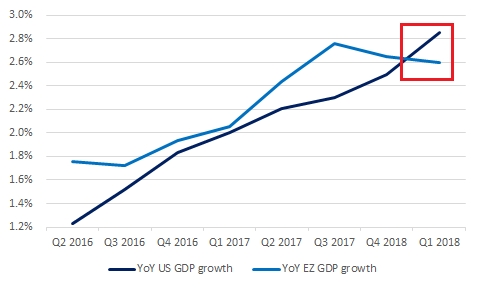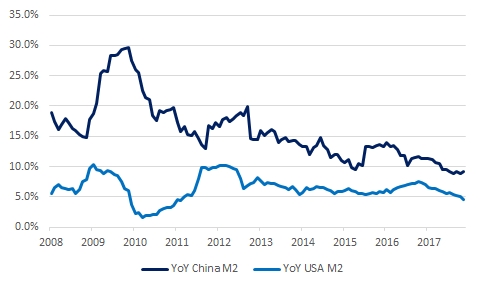- While US growth remains on track, picture is worsening in most other regions
- As cross-border US dollar loans fall, Fed about to make liquidity even tighter
- The epicenter of the dollar shortage is China, as emerging markets gorge on borrowed dollars
In our previous commentary on the US dollar, we warned that a weak dollar was hiding significant risks in growth-sensitive assets such as equities and European currencies. As the world’s reserve currency, the buck is inversely correlated to most financial assets because most cross-border lending is conducted in dollars. Thanks to a slowdown in economic growth outside the United States coupled with accelerating US inflation, we have upgraded our USD outlook to neutral. Following recent strength, we expect to upgrade our longer term outlook to bullish in the near future.
As US outperforms, rest of the world fails to keep up
Unlike most other currencies, the US dollar trades as a function of global growth relative to US growth. Given the wide availability of cross-border USD loans during a global upturn, more and more (borrowed) dollars chase international investment opportunities when investor sentiment is optimistic. As a result, the dollar weakens when international growth is on an accelerating trend. This explains why the currency weakened last year despite strong US growth. Today, international sentiment is falling sharply while US growth remains strong, meaning that fewer cross-border dollar loans will be issued going forward. US versus Eurozone growth is shown below:
Year-over-year US versus Eurozone growth GDP growth
Source: US BEA, Eurostat, MarketsNow
As can be seen above, US GDP growth remains on an accelerating trend, while Eurozone growth is forecast to slow in Q1 2018. Relative to actual US growth of 2.9% in Q1, forecasted Eurozone growth for the same quarter is 2.6%. As the Eurozone’s growth decelerates from its previous peak of 2.8% in Q3 2017, the euro is selling off as a result. As the euro is the world’s most important currency after the US dollar (given the significant size of the Eurozone’s economy), weakness in the currency pushes up the US dollar in relative terms. This is especially the case as other major European currencies (such as the British pound and the Swiss franc) are also tracking the euro lower.
Diverging growth = diverging monetary policy expectations
In the wake of strong US GDP growth figures and clear signs of wage inflation, the Federal Reserve has good reasons to maintain its guidance for three to four rate hikes this year. This is in sharp contrast with other major central banks who are grappling with worsening economic data. Last week, the European Central Bank highlighted “significant, sharp declines” in momentum indicators such as manufacturing PMIs. Poor Q1 GDP growth in the United Kingdom has also dashed hopes for the Bank of England, with May rate hike odds falling from 90% early last week to 20% more recently. The Bank of Japan also hinted that monetary easing is set to remain in place by removing a reference to achieving 2% inflation in 2019.
Strong growth and wage inflation means all clear for the Fed
Source: US BLS
As can be seen above, year-over-year wage inflation in Q1 2018 (Employment Cost Index: Wages and Salaries) has recently accelerated to 3.7%. Between year-over-year real GDP growth at 2.9% (ahead of expectations), and strong wage inflation, the Fed has all the data it needs to justify future rate hikes.
Big speculator short positions in the US dollar have yet to be unwound
Turning to sentiment, speculators continue to maintain outsized long positions in assets negatively correlated with the dollar. In particular, speculator net long positions in crude oil futures and options contracts are close to all-time highs. Net long positions in the euro are currently at multi-year highs. This is shown below:
Sell sell sell! Speculators still short the USD
Source: CFTC, MarketsNow
While positioning in both assets fell slightly last week, the investor community remains long in spite of the current bearish trend. In typical fashion, speculators chased the bullish trend in the euro and crude oil just as momentum was being exhausted. Now that long positions have built up to significant numbers, speculators are trapped as they have overstayed their welcome. Once speculators begin dumping their positions, expect the dollar to rise sharply.
Don’t bet on a political solution to China’s dollar woes
Lastly, there are underappreciated risks relating to the Chinese yuan. Beyond troubling developments relating to the Hong Kong dollar peg (a topic we covered in our previous commentary on the dollar), decelerating international growth means that the global dollar shortage may re-appear.
Today, the dollar is only rising as a function of slowing ex-US growth. Looking forward, US growth is also likely to start decelerating as base effects weigh on the future outlook (mathematically, positive year-over-year growth will become tougher going forward). In other regions, such as the Eurozone and Japan, the future outlook is already much weaker as forward-looking indicators suggest significant softening (beyond the base effect issue).
Once the global downturn arrives, expect the dollar shortage problem of 2015-2016 to return with a vengeance. While high-ranking members of Trump’s economic team are in China this week, even the best negotiators will struggle to unwind China’s dollar struggles. As we explained in a previous commentary on the global dollar shortage problem, emerging markets (led by China) are some of the biggest borrowers in the cross-border USD lending market (i.e. the Eurodollar market). A recent Bank of England bulletin on the dollar’s global role suggests that emerging markets are increasingly reliant on US dollar funding, to the tune of approximately $1T per year.
China’s problems are amplified as the country maintains a soft peg to the US dollar, despite maintaining very high rates of domestic money supply. A comparison of money supply growth for the US and China is shown below:
Rapid money supply growth + soft peg = pressure cooker
Source: Federal Reserve, IMF, MarketsNow
As can be seen above, China has consistently created money (i.e. through lending) at a much faster pace relative to the US. As the country anchors its currency on the value of the US dollar, the significant divergence in money supply growth is problematic during a downturn. In the upturn, domestic investors were content to chase real estate investments while yield-starved international investors extended US dollar loans to Chinese borrowers. Going forward, expect capital flight to re-appear as dollar lenders avoid China while domestic investors seek safe haven investments outside China. Given this dynamic, there is an increasing risk that China will be forced into devaluing the yuan as a means to cope with worsening dollar shortages.
As dollar looks poised to keep strengthening, time to adjust for the coming bear market
As global growth continues to slow, investors now have strong data supporting a more bearish stance on the future. Recent dollar strength is in line with previous slowdowns, as the cross-border US dollar credit pump starts to run dry. As liquidity is withdrawn from the market (a process exacerbated by a confident Federal Reserve), expect growth-sensitive assets such as equities and “risk-on” currencies to continue weakening. For now, the recent sell-off in financial markets have been relatively limited, as global growth remains relatively high. Once the global downturn arrives later this year, expect much greater gains in the US dollar as borrowers struggle to repay US dollar loans as global growth slows more sharply.




